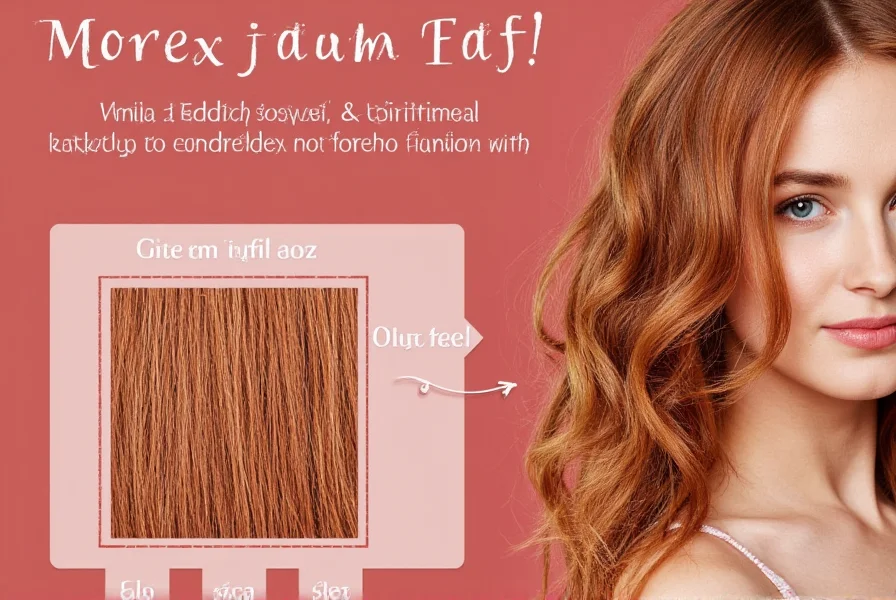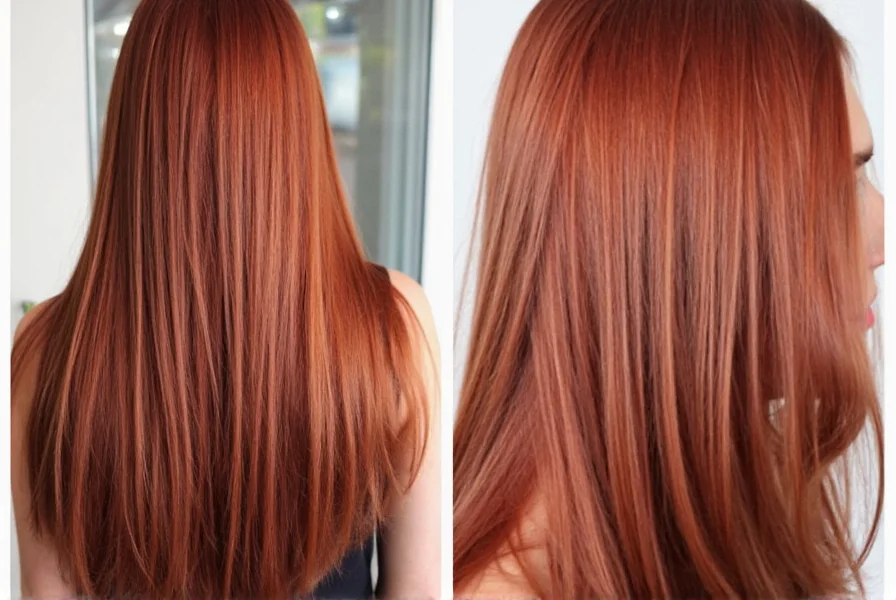Cinnamon hair color has surged in popularity as a sophisticated alternative to traditional red hair shades. This versatile hue combines the warmth of copper with the depth of brown, creating a multidimensional look that appears naturally sun-kissed rather than artificially colored. Understanding the nuances of this shade helps determine if it's right for your complexion and lifestyle.
What Exactly Is Cinnamon Hair Color?
Cinnamon hair exists on the spectrum between auburn and copper, but with distinctive characteristics that set it apart. The perfect cinnamon shade contains:
- A dominant reddish-brown base (not orange or violet-based)
- Subtle copper highlights that emerge in sunlight
- Warm undertones that complement golden or olive skin tones
- Natural-looking dimension without appearing dyed
Unlike fashion reds that require frequent touch-ups, cinnamon hair color often grows out gracefully, maintaining its appealing warmth even as roots show. Professional colorists typically achieve this shade by combining 50% red, 30% gold, and 20% brown pigments in formulations tailored to individual hair types.
Who Suits Cinnamon Hair Color Best?
While cinnamon hair color flatters many complexions, certain skin tones achieve particularly stunning results. The key factor is determining your undertone:
| Skin Undertone | Cinnamon Suitability | Recommended Variation |
|---|---|---|
| Warm (golden, peachy) | Excellent match | True cinnamon or light cinnamon |
| Neutral | Very good match | Medium cinnamon with subtle copper |
| Cool (pink, blue) | Proceed with caution | Deep cinnamon brown with minimal red |
| Olive | Excellent match | Rich cinnamon with golden highlights |
Individuals with warm undertones typically experience the most harmonious results with cinnamon hair color. Those with cool undertones can still achieve beautiful results by opting for deeper cinnamon brown variations with less red intensity. Eye color also plays a role—hazel, green, and golden-brown eyes create striking contrast against cinnamon hair.
Cinnamon vs. Similar Hair Color Shades
Many confuse cinnamon with other red-based hair colors. Understanding these distinctions helps select the perfect shade:
- Cinnamon vs. Auburn: Auburn contains more violet undertones and appears cooler, while cinnamon maintains warm copper tones
- Cinnamon vs. Copper: Copper is significantly brighter and more orange-toned, whereas cinnamon has brown balancing the red
- Cinnamon vs. Ginger: Ginger is lighter and more orange-red, while cinnamon has deeper brown bases
- Cinnamon vs. Mahogany: Mahogany leans toward purple-red, while cinnamon stays firmly in warm reddish-brown territory
When discussing cinnamon hair color for warm skin tones, professional colorists often recommend adding golden highlights to enhance the natural warmth. For those with fair complexions, lighter cinnamon variations prevent overwhelming the face, while deeper skin tones can carry richer cinnamon brown shades beautifully.
How to Achieve Cinnamon Hair Color
There are two primary approaches to achieving cinnamon hair:
Professional Coloring
For virgin hair (never colored), a single-process permanent color typically suffices. Colorists create custom cinnamon blends by mixing:
- 60% level 5 (light brown) or 6 (dark blonde) base
- 30% 5R (red) or 6R (red)
- 10% 7G (gold) for added warmth
For previously colored hair, a color correction may be necessary before applying cinnamon tones. Expect to invest $80-$150 for professional application, with touch-ups needed every 6-8 weeks.
At-Home Coloring
When attempting cinnamon hair color maintenance at home, consider these tips:
- Choose demi-permanent formulas for gradual buildup of color
- Look for "copper-infused" or "red-brown" shade names
- Perform strand tests before full application
- Use color-depositing conditioners for subtle enhancement
Box dyes labeled "cinnamon" often skew too orange. For better results, mix a light auburn shade with a golden brown shade in a 1:2 ratio. Always consult natural lighting when evaluating results—artificial light distorts red tones significantly.

Maintenance Tips for Cinnamon Hair
Preserving vibrant cinnamon hair color requires specific care routines. The copper pigments in cinnamon fade faster than standard brown tones, requiring special attention:
- Wash less frequently - Limit shampooing to 2-3 times weekly using sulfate-free formulas
- Cold water rinses - Prevents cuticle opening that releases color pigments
- Purple shampoo alternative - Use blue-based shampoos weekly to counteract brassiness
- UV protection - Apply leave-in treatments with UV filters before sun exposure
- Color-depositing conditioners - Use weekly to refresh copper tones
When discussing cinnamon hair color seasonal considerations, note that this shade often appears more vibrant in summer due to natural sun exposure enhancing the copper tones. During winter, you may need to refresh the color more frequently as indoor lighting can make cinnamon appear flatter.
Long-Term Considerations
Cinnamon hair color grows out more naturally than brighter reds, but proper transition planning ensures continuous flattering results:
- As roots grow, maintain dimensional appearance with shadow roots
- Seasonal adjustments: Lighten slightly for summer, deepen for winter
- Every 3-4 color applications, incorporate a color glaze for tonal refreshment
- Monitor for brassiness, especially if you have gray hairs
Unlike high-maintenance fashion colors, cinnamon hair offers remarkable versatility across seasons and aging. Many find it becomes more flattering with age as it complements developing golden undertones in mature skin.
Conclusion
Cinnamon hair color represents the perfect balance between bold red and natural brown, creating a warm, multidimensional look that flatters numerous complexions. By understanding your skin's undertones and selecting the appropriate cinnamon variation, you can achieve a vibrant yet natural-looking color that enhances your features without appearing artificially dyed. Proper maintenance preserves the rich copper tones while preventing unwanted brassiness, ensuring your cinnamon hair remains vibrant between salon visits. Whether you choose professional application or at-home coloring, cinnamon offers a sophisticated alternative to traditional red hair colors with superior grow-out properties.
Frequently Asked Questions
Does cinnamon hair color work for cool skin tones?
Yes, but with careful shade selection. Cool skin tones should opt for deeper cinnamon brown variations with minimal red intensity. Look for formulations with more brown base (level 4-5) and less red pigment. Adding subtle ash tones can help balance the warmth while maintaining the cinnamon essence. Consulting a professional colorist ensures the perfect customized blend for cool undertones.
How often should I touch up cinnamon hair color?
Professional cinnamon color typically requires touch-ups every 6-8 weeks. The warm copper tones fade faster than standard brown, so maintenance is crucial. At-home color users may need to refresh every 4-6 weeks using demi-permanent formulas. Using color-depositing conditioners weekly can extend time between full applications by refreshing the copper tones without additional chemical processing.
Can I achieve cinnamon hair color on dark brown hair without bleaching?
Yes, but the results will be more subtle. On dark brown hair (level 3-4), cinnamon appears as rich, dimensional lowlights rather than an all-over color change. For noticeable results without bleaching, use a demi-permanent cinnamon gloss or glaze that deposits warm tones without lifting your natural pigment. Multiple applications build subtle warmth. For dramatic transformation, some lightening may be necessary, but many find the natural-looking dimensional effect on dark hair preferable to full coverage.
What's the difference between cinnamon and auburn hair color?
Cinnamon contains warm copper undertones with a brown base, while auburn has cooler violet-red undertones. Cinnamon appears more golden and earthy, resembling the spice, while auburn leans toward burgundy. Cinnamon generally works better for warm and olive skin tones, while auburn flatters cooler complexions. The brown component in cinnamon makes it less intense than traditional auburn, creating a more natural-looking red variation that grows out more seamlessly.
How do I prevent my cinnamon hair from turning brassy?
Prevent brassiness in cinnamon hair by using blue-based shampoos once weekly (not purple, which counters yellow in blondes). Incorporate color-depositing conditioners with copper tones to refresh warmth without adding brass. Always use heat protectants with UV filters before styling or sun exposure. Wash with cool water and avoid excessive chlorine exposure. If brassiness occurs, a professional toning service with violet-based glaze can neutralize unwanted orange tones while preserving the cinnamon essence.











 浙公网安备
33010002000092号
浙公网安备
33010002000092号 浙B2-20120091-4
浙B2-20120091-4